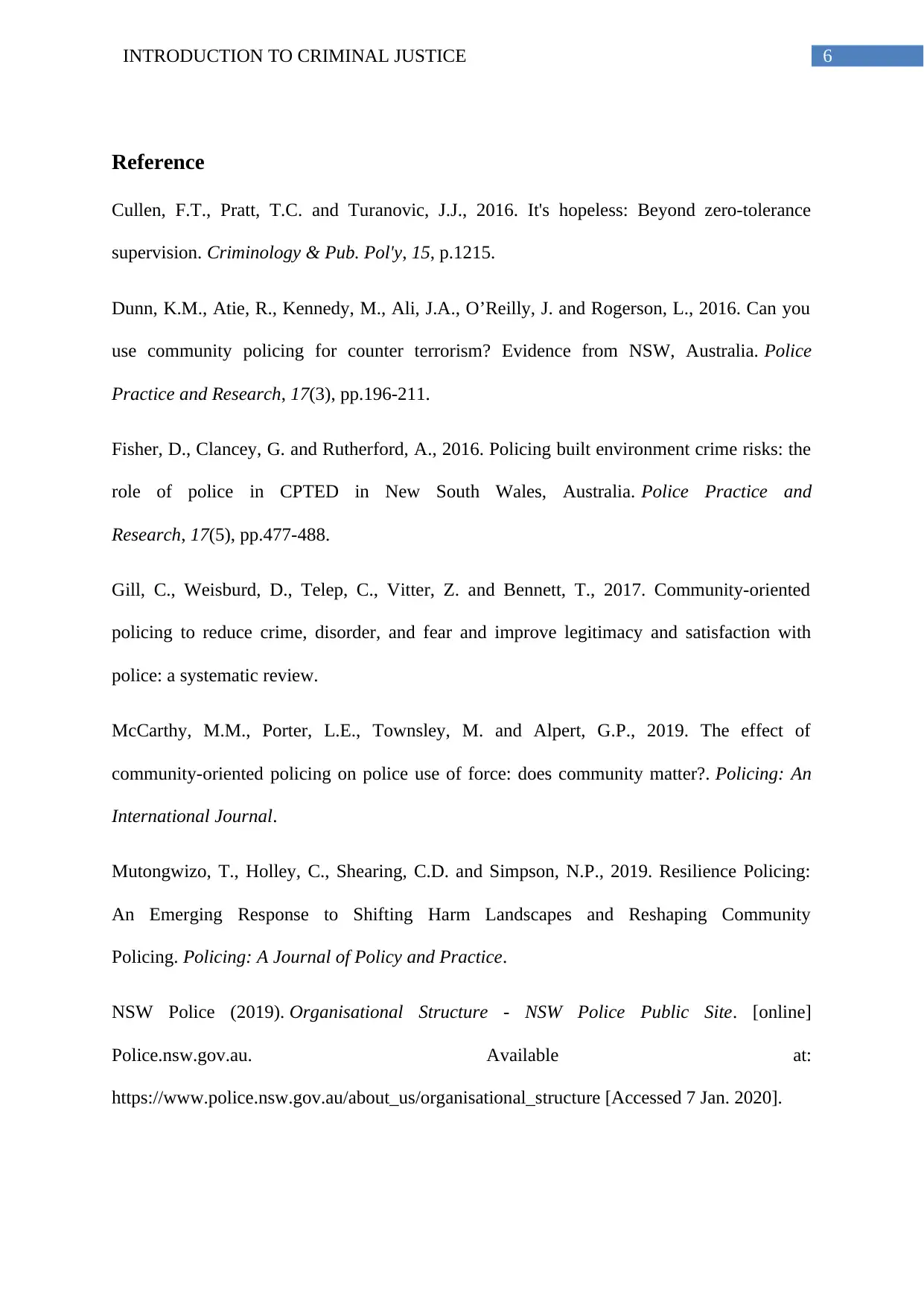Analysis of Policing Practices in NSW: Criminal Justice Report
VerifiedAdded on 2022/08/30
|9
|2395
|23
Report
AI Summary
This report provides an in-depth analysis of policing practices in New South Wales (NSW), focusing on community-oriented and zero-tolerance models. It begins by defining policing and the role of the NSW Police Force (NSWPF), detailing its structure, functions, and the community-based model it employs. The report then contrasts community-oriented policing with the zero-tolerance model, outlining the pros and cons of each approach, and referencing the "broken windows theory." It critically examines whether the model promoted by the NSW government is effectively implemented and should be the primary approach. Furthermore, the report addresses challenges faced by the NSWPF, such as the over-imprisonment of Aboriginal and Torres Strait Islander people, and cites crime statistics to evaluate the effectiveness of the community-based model. The analysis concludes that while the community-based model is effective in deterring crime, as evidenced by declining serious crime rates, the zero-tolerance model is not currently necessary for NSW. The report draws upon academic sources to support its claims and provides a comprehensive overview of policing strategies and their implications within the context of criminal justice in NSW.

Running head: INTRODUCTION TO CRIMINAL JUSTICE
INTRODUCTION TO CRIMINAL JUSTICE
Name of Student
Name of University
Author Note
INTRODUCTION TO CRIMINAL JUSTICE
Name of Student
Name of University
Author Note
Paraphrase This Document
Need a fresh take? Get an instant paraphrase of this document with our AI Paraphraser

1INTRODUCTION TO CRIMINAL JUSTICE
Answer 1
Policing Practices in the New South Wales
The term police is defined as an established form of individuals empowered by a
nation for the enforcement of the law, defending the people’s lives, freedom and properties of
citizens, and prevention of crime and the complaints which are civil in nature (Sausdal 2017).
The legalized influences that the police is seen as exercise include seizure and the use of
force in a way that is considered to be legitimized. The term policing, in this context is
described as properly maintaining the law and order of a place by the forces in the police
service (Shearing 2018). Policing can further be defined as overseeing or imposing
guidelines. As example of policing it is seen that the schools might get requests that schools
discharge students at altered times for the reduction of chances for fights or bullying.
The New South Wales Police Force (NSW Police Force), which was formerly known
as New South Wales Police Service and New South Wales Police, is considered as the major
law enforcement agency in the state of New South Wales in Australia. The administration of
the New South Wales Police Department is divided into two sections. The metropolitan areas
of the New South Wales are supervised under the jurisdiction of the Police Area Commands
(PACs) and the provincial and country areas of of the New South Wales are looked after
under the jurisdiction of the Police Districts (PDs). The purposes served by the New South
Wales Police Force are seen to have influence on the fellows of the community by way of the
establishment of amenities. These facilities are observed as including the providing of the
services related to policing to the jurisdiction of New South Wales and exercising different
purposes deliberated on the police force by provisions mentioned in the Police Act 1990 or
any similar legislation. The services provided by the New South Wales police force include
the services to the customers to be receptive and eloquent. The general undertaking of the
Answer 1
Policing Practices in the New South Wales
The term police is defined as an established form of individuals empowered by a
nation for the enforcement of the law, defending the people’s lives, freedom and properties of
citizens, and prevention of crime and the complaints which are civil in nature (Sausdal 2017).
The legalized influences that the police is seen as exercise include seizure and the use of
force in a way that is considered to be legitimized. The term policing, in this context is
described as properly maintaining the law and order of a place by the forces in the police
service (Shearing 2018). Policing can further be defined as overseeing or imposing
guidelines. As example of policing it is seen that the schools might get requests that schools
discharge students at altered times for the reduction of chances for fights or bullying.
The New South Wales Police Force (NSW Police Force), which was formerly known
as New South Wales Police Service and New South Wales Police, is considered as the major
law enforcement agency in the state of New South Wales in Australia. The administration of
the New South Wales Police Department is divided into two sections. The metropolitan areas
of the New South Wales are supervised under the jurisdiction of the Police Area Commands
(PACs) and the provincial and country areas of of the New South Wales are looked after
under the jurisdiction of the Police Districts (PDs). The purposes served by the New South
Wales Police Force are seen to have influence on the fellows of the community by way of the
establishment of amenities. These facilities are observed as including the providing of the
services related to policing to the jurisdiction of New South Wales and exercising different
purposes deliberated on the police force by provisions mentioned in the Police Act 1990 or
any similar legislation. The services provided by the New South Wales police force include
the services to the customers to be receptive and eloquent. The general undertaking of the

2INTRODUCTION TO CRIMINAL JUSTICE
police force is ensuring the protection of the life and possessions of the individuals and for
the recognition and deterrence of crimes. The services that the New South Wales Police
Force provide is seen as including deterrence, exposure and exploration of the crimes;
maintenance of the communal order; managing the situations in emergency; performance and
organization of the operations for exploration and rescue of individuals; and Observing and
endorsing road safety.
The model followed by the New South Wales police department for their operations is
the community based model. The term community-oriented policing is described as a policy
in the policing that emphases on building connections and operating diligently with the
citizens in the communities (Dunn et al. 2016). The chief objective of the system of
community based policing is building of relation with the public by the police forces through
interactions with the local organizations and the fellows of the communal, generating
partnership and tactics for the reduction of the criminal activities and disorders. Community
based model of policing can further be observed as being connected to the problem oriented
model of the policing and intelligence based model of the policing, and can further be seen
as contradicting with reactive tactics in the policing (McCarthy et al 2019). Even though the
model of community based policing typically objects towards the criminal activities and
disorders that are low level, however, as per the ‘broken windows theory’ it is stated that
there would be more reduction of serious criminal activities by way of the community based
policing as well (Gill et al 2017). The broken window theory, first discovered by James Q.
Wilson and George Kelling in 1982, proposes that if the visible signs of disorder are cleaned
then it will help in the prevention of serious crimes (Welsh, Braga and Bruinsma 2015).
There are certain challenges that the New South Wales police department is seen as facing as
well for their approach towards policing. One of the major problems that has been repeatedly
reported over the years is the over imprisonment of Aboriginal and Torres Strait Islander
police force is ensuring the protection of the life and possessions of the individuals and for
the recognition and deterrence of crimes. The services that the New South Wales Police
Force provide is seen as including deterrence, exposure and exploration of the crimes;
maintenance of the communal order; managing the situations in emergency; performance and
organization of the operations for exploration and rescue of individuals; and Observing and
endorsing road safety.
The model followed by the New South Wales police department for their operations is
the community based model. The term community-oriented policing is described as a policy
in the policing that emphases on building connections and operating diligently with the
citizens in the communities (Dunn et al. 2016). The chief objective of the system of
community based policing is building of relation with the public by the police forces through
interactions with the local organizations and the fellows of the communal, generating
partnership and tactics for the reduction of the criminal activities and disorders. Community
based model of policing can further be observed as being connected to the problem oriented
model of the policing and intelligence based model of the policing, and can further be seen
as contradicting with reactive tactics in the policing (McCarthy et al 2019). Even though the
model of community based policing typically objects towards the criminal activities and
disorders that are low level, however, as per the ‘broken windows theory’ it is stated that
there would be more reduction of serious criminal activities by way of the community based
policing as well (Gill et al 2017). The broken window theory, first discovered by James Q.
Wilson and George Kelling in 1982, proposes that if the visible signs of disorder are cleaned
then it will help in the prevention of serious crimes (Welsh, Braga and Bruinsma 2015).
There are certain challenges that the New South Wales police department is seen as facing as
well for their approach towards policing. One of the major problems that has been repeatedly
reported over the years is the over imprisonment of Aboriginal and Torres Strait Islander
⊘ This is a preview!⊘
Do you want full access?
Subscribe today to unlock all pages.

Trusted by 1+ million students worldwide

3INTRODUCTION TO CRIMINAL JUSTICE
people. The police force in the New South Wales is seen as given the opportunity of using
their own discretion on the situations when they doubt that an individual is guilty of
committing a felony. Therefore from the above discussion the definitions of policing are
observed to be straightforward and not complex at all, even though there are certain
disparities between the definitions and the actual practice.
Answer 2
Zero-tolerance model of policing is often described as a stringent tactic for the
enforcement of non-discretionary law which might often be considered as being harsh on
criminal activities. Under the provisions mentioned in the method, the police force is seen as
enforcing all aspect of the law. Even the minor criminal activities are seen as closely
monitored under the Zero-tolerance model of policing (Taylor 2019) The minor offences can
as well be including graffiti, drinking alcohol in the public, begging, destruction, and
panhandling.
The term community-oriented policing is labelled as a policy in the policing that
stress on structuring networks and functioning assiduously with the residents in the
communities. The paramount objective of the arrangement of community based policing is
structuring relation with the community by the police forces by way of interrelating with the
resident groups and the associates in the community, making partnership and strategies for
the lessening of the illicit actions and disarrays. Community oriented model of policing can
further be witnessed as being linked to the problem based model and intelligence oriented
model of the policing. In furtherance, this model is also understood as challenging with
reactive tactics in the policing (Mutongwizo et al. 2019). Even though the model of
community based policing typically objects towards the criminal activities and disorders that
are low level, however, as per the ‘broken windows theory’ it is stated that there would be
people. The police force in the New South Wales is seen as given the opportunity of using
their own discretion on the situations when they doubt that an individual is guilty of
committing a felony. Therefore from the above discussion the definitions of policing are
observed to be straightforward and not complex at all, even though there are certain
disparities between the definitions and the actual practice.
Answer 2
Zero-tolerance model of policing is often described as a stringent tactic for the
enforcement of non-discretionary law which might often be considered as being harsh on
criminal activities. Under the provisions mentioned in the method, the police force is seen as
enforcing all aspect of the law. Even the minor criminal activities are seen as closely
monitored under the Zero-tolerance model of policing (Taylor 2019) The minor offences can
as well be including graffiti, drinking alcohol in the public, begging, destruction, and
panhandling.
The term community-oriented policing is labelled as a policy in the policing that
stress on structuring networks and functioning assiduously with the residents in the
communities. The paramount objective of the arrangement of community based policing is
structuring relation with the community by the police forces by way of interrelating with the
resident groups and the associates in the community, making partnership and strategies for
the lessening of the illicit actions and disarrays. Community oriented model of policing can
further be witnessed as being linked to the problem based model and intelligence oriented
model of the policing. In furtherance, this model is also understood as challenging with
reactive tactics in the policing (Mutongwizo et al. 2019). Even though the model of
community based policing typically objects towards the criminal activities and disorders that
are low level, however, as per the ‘broken windows theory’ it is stated that there would be
Paraphrase This Document
Need a fresh take? Get an instant paraphrase of this document with our AI Paraphraser

4INTRODUCTION TO CRIMINAL JUSTICE
more reduction of serious criminal activities by way of the community based policing as well
(Walsh 2018). Both the Zero-tolerance model of policing and Community based model of
policing is seen as having certain pros and cons.
Zero-tolerance model of policing objects for the prevention of the severe criminal
activities by way of fastening down even the slight offenses such as the graffiti that the
experts consider to be leading to additional offences. In furtherance, in this model, even for
the first felonies the offenders are charged with prison sentences. Zero-tolerance model of
policing is seen as providing a dominant restraining to the activities of the criminals. In
following Zero-tolerance model of policing offenders are less likely commit re-offences
because in the zero tolerance system the police is seen as catching the offenders promptly on
during the accelerating round of criminalities. As there are strict punishments for crimes
people are more likely to be deterring from criminal behaviours. It is also seen as to be
effective in the reduction of drug dealing and abuse (Walklate and Evans 2019).
The cons in the Zero-tolerance model of policing include that many offenders who
commit minor crimes, or are low level members in a gang, might not be aware of the
consequences for their offences. These types of offences would be reduced if there is a
change in the structure of the society and not with the severity of punishments (Cullen, Pratt
and Turanovic 2016). In the zero tolerance policy system the re-offending rates is seen as
being higher.
The pros in the Community based model of policing includes: bringing the public and
the police nearer; good for deterring crimes; the community is educated about the crimes; the
police is seen as having commitment towards the society (Peyton, Sierra-Arévalo and Rand
2019).
more reduction of serious criminal activities by way of the community based policing as well
(Walsh 2018). Both the Zero-tolerance model of policing and Community based model of
policing is seen as having certain pros and cons.
Zero-tolerance model of policing objects for the prevention of the severe criminal
activities by way of fastening down even the slight offenses such as the graffiti that the
experts consider to be leading to additional offences. In furtherance, in this model, even for
the first felonies the offenders are charged with prison sentences. Zero-tolerance model of
policing is seen as providing a dominant restraining to the activities of the criminals. In
following Zero-tolerance model of policing offenders are less likely commit re-offences
because in the zero tolerance system the police is seen as catching the offenders promptly on
during the accelerating round of criminalities. As there are strict punishments for crimes
people are more likely to be deterring from criminal behaviours. It is also seen as to be
effective in the reduction of drug dealing and abuse (Walklate and Evans 2019).
The cons in the Zero-tolerance model of policing include that many offenders who
commit minor crimes, or are low level members in a gang, might not be aware of the
consequences for their offences. These types of offences would be reduced if there is a
change in the structure of the society and not with the severity of punishments (Cullen, Pratt
and Turanovic 2016). In the zero tolerance policy system the re-offending rates is seen as
being higher.
The pros in the Community based model of policing includes: bringing the public and
the police nearer; good for deterring crimes; the community is educated about the crimes; the
police is seen as having commitment towards the society (Peyton, Sierra-Arévalo and Rand
2019).

5INTRODUCTION TO CRIMINAL JUSTICE
The cons in the Community based model of policing includes: there might be struggle
among certain citizens for gaining more power or being authoritative; it created deviance
activities; as the community also includes in the deterrence of crime therefore there might be
varieties of ideas clashing (Schanzer et al. 2016).
The model followed by the New South Wales police department for their operations is
the community based model. There are some definite challenges that the New South Wales
police department is seen as facing as well for their approach towards policing (Fisher,
Clancey and Rutherford 2016).The police force in the New South Wales is seen as given the
prospect of using their own freedom of choice on the circumstances when they suspect that
an individual is guilty of committing a felony (YouTube, 2015). The purposes obliged by the
New South Wales Police Force are seen as partaking effect on the companions of the
communal by way of the formation of services.
One of the major problems that has been repeatedly reported over the years is the over
imprisonment of Aboriginal and Torres Strait Islander people (NSW Police, 2019). As per the
crime statistics provided by the New South Wales police department it is observed that in
2019 there has been mostly been downward trends in offences in the major categories, like
breaking and entering, stealing from person or from dwelling and inflicting malicious damage
towards property. The report is also seen as providing that there has been decline in the
violent crimes as well (Police.nsw.gov.au, 2019). Therefore based on the report it is said that
the community based model of policing in the New South Wales region is effective to deter
crime as there has been a steady decline in the serious crimes by following the community
based models. Hence, there is no necessity for a zero tolerance model to be set up currently in
the NSW police system.
The cons in the Community based model of policing includes: there might be struggle
among certain citizens for gaining more power or being authoritative; it created deviance
activities; as the community also includes in the deterrence of crime therefore there might be
varieties of ideas clashing (Schanzer et al. 2016).
The model followed by the New South Wales police department for their operations is
the community based model. There are some definite challenges that the New South Wales
police department is seen as facing as well for their approach towards policing (Fisher,
Clancey and Rutherford 2016).The police force in the New South Wales is seen as given the
prospect of using their own freedom of choice on the circumstances when they suspect that
an individual is guilty of committing a felony (YouTube, 2015). The purposes obliged by the
New South Wales Police Force are seen as partaking effect on the companions of the
communal by way of the formation of services.
One of the major problems that has been repeatedly reported over the years is the over
imprisonment of Aboriginal and Torres Strait Islander people (NSW Police, 2019). As per the
crime statistics provided by the New South Wales police department it is observed that in
2019 there has been mostly been downward trends in offences in the major categories, like
breaking and entering, stealing from person or from dwelling and inflicting malicious damage
towards property. The report is also seen as providing that there has been decline in the
violent crimes as well (Police.nsw.gov.au, 2019). Therefore based on the report it is said that
the community based model of policing in the New South Wales region is effective to deter
crime as there has been a steady decline in the serious crimes by following the community
based models. Hence, there is no necessity for a zero tolerance model to be set up currently in
the NSW police system.
⊘ This is a preview!⊘
Do you want full access?
Subscribe today to unlock all pages.

Trusted by 1+ million students worldwide

6INTRODUCTION TO CRIMINAL JUSTICE
Reference
Cullen, F.T., Pratt, T.C. and Turanovic, J.J., 2016. It's hopeless: Beyond zero-tolerance
supervision. Criminology & Pub. Pol'y, 15, p.1215.
Dunn, K.M., Atie, R., Kennedy, M., Ali, J.A., O’Reilly, J. and Rogerson, L., 2016. Can you
use community policing for counter terrorism? Evidence from NSW, Australia. Police
Practice and Research, 17(3), pp.196-211.
Fisher, D., Clancey, G. and Rutherford, A., 2016. Policing built environment crime risks: the
role of police in CPTED in New South Wales, Australia. Police Practice and
Research, 17(5), pp.477-488.
Gill, C., Weisburd, D., Telep, C., Vitter, Z. and Bennett, T., 2017. Community-oriented
policing to reduce crime, disorder, and fear and improve legitimacy and satisfaction with
police: a systematic review.
McCarthy, M.M., Porter, L.E., Townsley, M. and Alpert, G.P., 2019. The effect of
community-oriented policing on police use of force: does community matter?. Policing: An
International Journal.
Mutongwizo, T., Holley, C., Shearing, C.D. and Simpson, N.P., 2019. Resilience Policing:
An Emerging Response to Shifting Harm Landscapes and Reshaping Community
Policing. Policing: A Journal of Policy and Practice.
NSW Police (2019). Organisational Structure - NSW Police Public Site. [online]
Police.nsw.gov.au. Available at:
https://www.police.nsw.gov.au/about_us/organisational_structure [Accessed 7 Jan. 2020].
Reference
Cullen, F.T., Pratt, T.C. and Turanovic, J.J., 2016. It's hopeless: Beyond zero-tolerance
supervision. Criminology & Pub. Pol'y, 15, p.1215.
Dunn, K.M., Atie, R., Kennedy, M., Ali, J.A., O’Reilly, J. and Rogerson, L., 2016. Can you
use community policing for counter terrorism? Evidence from NSW, Australia. Police
Practice and Research, 17(3), pp.196-211.
Fisher, D., Clancey, G. and Rutherford, A., 2016. Policing built environment crime risks: the
role of police in CPTED in New South Wales, Australia. Police Practice and
Research, 17(5), pp.477-488.
Gill, C., Weisburd, D., Telep, C., Vitter, Z. and Bennett, T., 2017. Community-oriented
policing to reduce crime, disorder, and fear and improve legitimacy and satisfaction with
police: a systematic review.
McCarthy, M.M., Porter, L.E., Townsley, M. and Alpert, G.P., 2019. The effect of
community-oriented policing on police use of force: does community matter?. Policing: An
International Journal.
Mutongwizo, T., Holley, C., Shearing, C.D. and Simpson, N.P., 2019. Resilience Policing:
An Emerging Response to Shifting Harm Landscapes and Reshaping Community
Policing. Policing: A Journal of Policy and Practice.
NSW Police (2019). Organisational Structure - NSW Police Public Site. [online]
Police.nsw.gov.au. Available at:
https://www.police.nsw.gov.au/about_us/organisational_structure [Accessed 7 Jan. 2020].
Paraphrase This Document
Need a fresh take? Get an instant paraphrase of this document with our AI Paraphraser

7INTRODUCTION TO CRIMINAL JUSTICE
Peyton, K., Sierra-Arévalo, M. and Rand, D.G., 2019. A field experiment on community
policing and police legitimacy. Proceedings of the National Academy of Sciences, 116(40),
pp.19894-19898.
Police.nsw.gov.au (2019). Crime Statistics - NSW Police Public Site. [online]
Police.nsw.gov.au. Available at:
https://www.police.nsw.gov.au/about_us/publications/publications/crime_statistics [Accessed
7 Jan. 2020].
Sausdal, D., 2017. Leanne Weber, Policing Non-Citizens.
Schanzer, D.H., Kurzman, C., Toliver, J. and Miller, E., 2016. The challenge and promise of
using community policing strategies to prevent violent extremism: A call for community
partnerships with law enforcement to enhance public safety. Durham: Triangle Center on
Terrorism and Homeland Security.
Shearing, C., 2018. Reinventing policing: Policing as governance. In Policing change,
changing police (pp. 285-307). Routledge.
Taylor, R.B., 2019. Incivilities Reduction Policing, Zero Tolerance, and the Retreat from
Coproduction: Even Weaker Foundations and Stronger Pressures. Police Innovation:
Contrasting Perspectives, p.142.
Walklate, S. and Evans, K., 2019. Zero tolerance or community tolerance?: managing crime
in high crime areas. Routledge.
Walsh, J., 2018. Report and deport: Public vigilance and migration policing in
Australia. Theoretical Criminology, p.1362480618756363.
Welsh, B.C., Braga, A.A. and Bruinsma, G.J., 2015. Reimagining broken windows: From
theory to policy. Journal of Research in Crime and Delinquency, 52(4), pp.447-463.
Peyton, K., Sierra-Arévalo, M. and Rand, D.G., 2019. A field experiment on community
policing and police legitimacy. Proceedings of the National Academy of Sciences, 116(40),
pp.19894-19898.
Police.nsw.gov.au (2019). Crime Statistics - NSW Police Public Site. [online]
Police.nsw.gov.au. Available at:
https://www.police.nsw.gov.au/about_us/publications/publications/crime_statistics [Accessed
7 Jan. 2020].
Sausdal, D., 2017. Leanne Weber, Policing Non-Citizens.
Schanzer, D.H., Kurzman, C., Toliver, J. and Miller, E., 2016. The challenge and promise of
using community policing strategies to prevent violent extremism: A call for community
partnerships with law enforcement to enhance public safety. Durham: Triangle Center on
Terrorism and Homeland Security.
Shearing, C., 2018. Reinventing policing: Policing as governance. In Policing change,
changing police (pp. 285-307). Routledge.
Taylor, R.B., 2019. Incivilities Reduction Policing, Zero Tolerance, and the Retreat from
Coproduction: Even Weaker Foundations and Stronger Pressures. Police Innovation:
Contrasting Perspectives, p.142.
Walklate, S. and Evans, K., 2019. Zero tolerance or community tolerance?: managing crime
in high crime areas. Routledge.
Walsh, J., 2018. Report and deport: Public vigilance and migration policing in
Australia. Theoretical Criminology, p.1362480618756363.
Welsh, B.C., Braga, A.A. and Bruinsma, G.J., 2015. Reimagining broken windows: From
theory to policy. Journal of Research in Crime and Delinquency, 52(4), pp.447-463.

8INTRODUCTION TO CRIMINAL JUSTICE
YouTube (2015). Policing Methods: Adopting a Strategy. [online] YouTube. Available at:
https://www.youtube.com/watch?v=W3YdSOyd9pU [Accessed 7 Jan. 2020].
YouTube (2015). Policing Methods: Adopting a Strategy. [online] YouTube. Available at:
https://www.youtube.com/watch?v=W3YdSOyd9pU [Accessed 7 Jan. 2020].
⊘ This is a preview!⊘
Do you want full access?
Subscribe today to unlock all pages.

Trusted by 1+ million students worldwide
1 out of 9
Related Documents
Your All-in-One AI-Powered Toolkit for Academic Success.
+13062052269
info@desklib.com
Available 24*7 on WhatsApp / Email
![[object Object]](/_next/static/media/star-bottom.7253800d.svg)
Unlock your academic potential
Copyright © 2020–2025 A2Z Services. All Rights Reserved. Developed and managed by ZUCOL.





